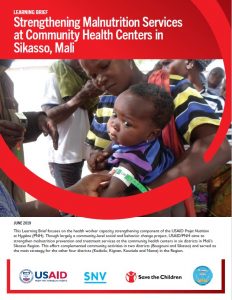
This Learning Brief focuses on the health worker capacity strengthening component of the USAID Projet Nutrition et Hygiène (PNH).
The high prevalence of malnutrition in Mali is a major public health problem. At the start of the project in Sikasso Region, the breadbasket of Mali, chronic malnutrition was 33 percent and acute malnutrition was 9.4 percent in children age 6–59 months, close to the WHO’s determination of an emergency. Food and childcare practices were suboptimal, contributing to these statistics: only 35 percent of children under 6 months were breastfed, 48 percent of children received a minimum frequency of meals, and only 8 percent of children had at least four food groups in their diets. Further, most families sold the food they grew rather than feed it to their families.
In 2014, Save the Children began implementing the USAID/PNH project in Sikasso to improve the nutritional status of pregnant and lactating women and children under age 2 in six districts—using the 1,000 Day approach. The project aimed to strengthen nutrition services for managing acute malnutrition in some community health centers (CSCOM) in all six districts. In two districts, Bougouni and Sikasso, the project added intensive behavior change activities in communities to complement activities at the health center level. These activities focused on improving nutrition; water, sanitation, and hygiene (WASH); and agricultural practices.
Though largely a community-level social and behavior change project, USAID/PNH aims to strengthen malnutrition prevention and treatment services at the community health centers in six districts in Mali’s Sikasso Region. This effort complemented community activities in two districts (Bougouni and Sikasso) and served as the main strategy for the other four districts (Kadiolo, Kignan, Koutiala and Niena) in the Region.